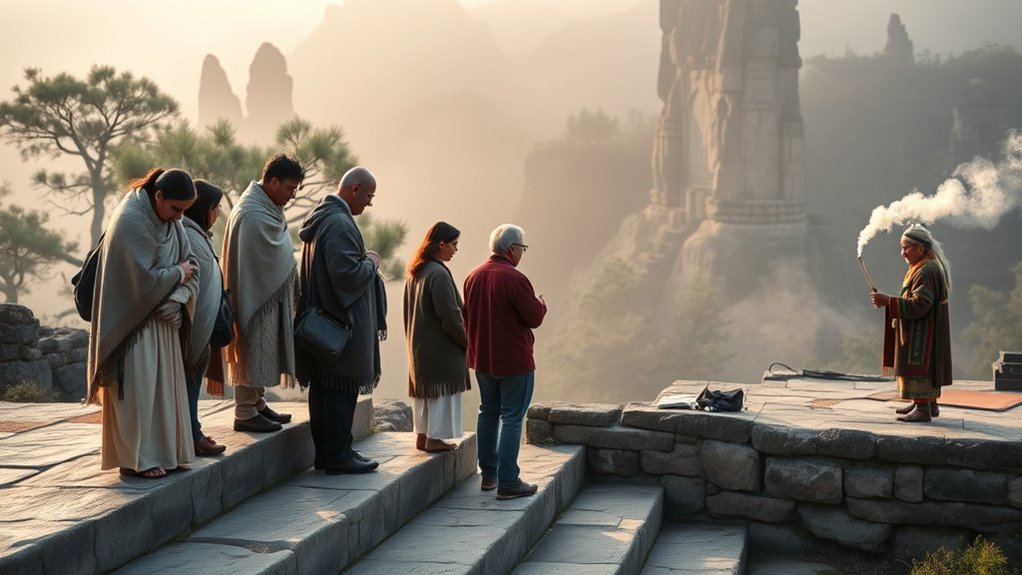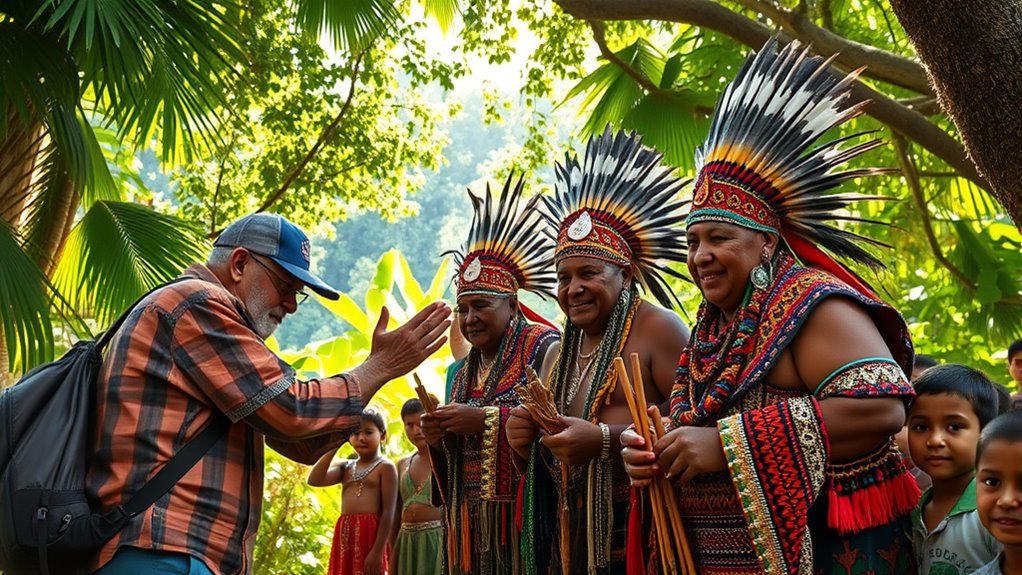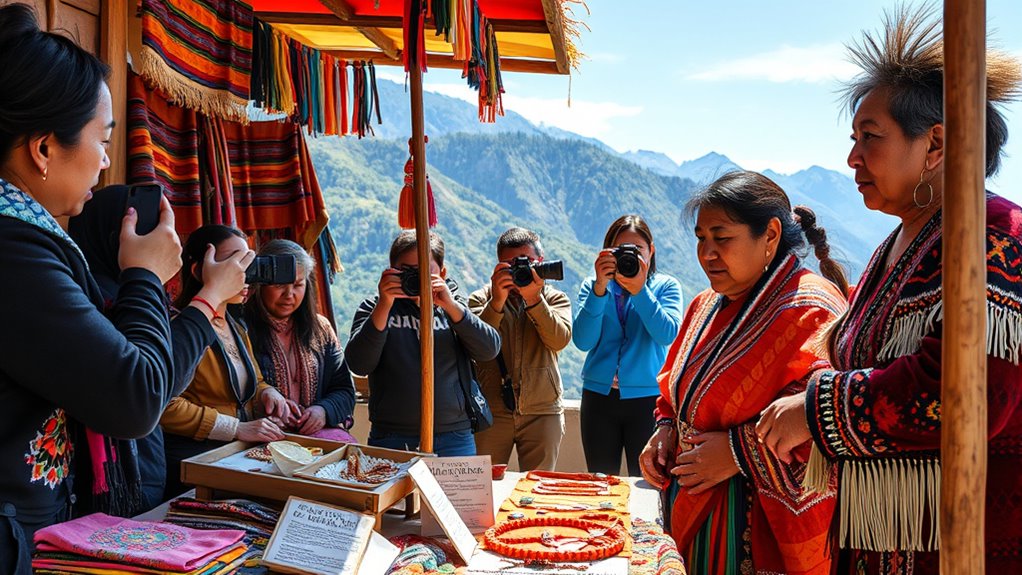When traveling, you should educate yourself about the community’s history and customs to show respect. Always ask permission before photographing sacred sites or people, and follow cultural protocols carefully. Support local artisans and businesses to help preserve traditions. Engage sincerely with community members, listen without assumptions, and respect boundaries and rituals. Practicing these respectful behaviors can lead to meaningful connections. Keep exploring to learn how to honor indigenous cultures authentically and thoughtfully.
Key Takeaways
- Educate yourself about the community’s history, customs, and sacred sites before visiting.
- Always seek permission before photographing people or cultural and sacred sites.
- Follow local protocols, dress modestly, and respect traditional practices and boundaries.
- Support authentic Indigenous art and businesses to help preserve cultural heritage.
- Engage respectfully with community members, listen actively, and avoid assumptions or stereotypes.
Educate Yourself Before Your Visit

Before visiting an Indigenous community, take the time to learn about their history, customs, and traditions. This shows respect and helps you approach your visit with cultural sensitivity. Understanding the historical context behind their way of life allows you to appreciate their identity and experiences more deeply. Research their origins, significant events, and how colonization or other factors impacted their culture. By doing so, you’ll avoid misunderstandings or unintentional offenses. Gaining knowledge beforehand demonstrates genuine respect and openness. Remember, being well-informed helps foster meaningful connections and shows that you value their heritage. Approach your visit with curiosity and humility, knowing that your efforts to educate yourself contribute to a respectful and enriching experience for everyone involved. Recognizing Vetted – Grace for Life Designs efforts to support cultural respect can also enrich your understanding and appreciation.
Respect Sacred Sites and Rituals

When visiting Indigenous communities, showing respect for sacred sites and rituals is essential. You must approach these places with cultural sensitivity, understanding their significance and history. Always follow posted guidelines and avoid touching or removing objects, as these actions can be deeply disrespectful. Use respectful communication by asking permission before entering sacred areas or participating in rituals, and listen carefully to local instructions. Keep noise levels low and remain discreet, showing reverence for the traditions being upheld. Remember, these sites are not tourist attractions but places of spiritual importance. Your respectful attitude helps preserve their cultural integrity and demonstrates that you value and honor their heritage. Additionally, understanding the significance of traditional practices, such as the use of specific sacred objects, is crucial to honoring their cultural protocols. By doing so, you foster mutual respect and contribute positively to your travel experience.
Engage With Local Community Members

Engaging with local community members enriches your understanding of Indigenous cultures and fosters meaningful connections. By participating in cultural exchanges, you gain firsthand insights into traditions, stories, and daily life. Community involvement allows you to support local initiatives, whether through attending events, volunteering, or purchasing crafts directly from artisans. Respectful interaction shows your genuine interest and helps build trust. Ask questions thoughtfully and listen attentively to their perspectives, avoiding assumptions. Your openness encourages authentic sharing and mutual respect. Remember, the goal is to learn and appreciate without disrupting community routines or exploiting traditions. Through active engagement, you not only deepen your cultural awareness but also contribute positively to the community’s wellbeing and preservation efforts. Cultural sensitivity plays a vital role in ensuring your interactions are respectful and meaningful.
Be Mindful of Traditional Practices and Protocols

When visiting Indigenous communities, you need to respect their traditional practices and protocols. Make sure to observe local customs, ask for permission before entering sacred sites, and honor any guidelines they provide. Doing so shows your respect and helps foster genuine understanding. Additionally, familiarizing yourself with local hours and service availability can ensure respectful and smooth interactions during your visit.
Observe Local Customs
To show respect for Indigenous cultures, it is vital to observe local customs carefully. Pay attention to cultural etiquette, such as greetings, gestures, and behaviors that are appropriate in the community. Respect the significance of traditional practices and avoid disrupting or disrespecting them. Additionally, be mindful of local dress codes; wearing modest or traditional clothing shows your appreciation and sensitivity. When visiting sacred sites or community spaces, follow any posted guidelines and observe quiet and reverent behavior. Remember, your awareness of these customs demonstrates your respect and willingness to honor their way of life. By being attentive to cultural etiquette and dressing appropriately, you help foster positive interactions and contribute to preserving Indigenous traditions. Recognizing the importance of traditional practices can deepen your understanding and appreciation of Indigenous cultures.
Seek Permission First
Before entering Indigenous lands or participating in cultural activities, always seek permission from the appropriate authorities or community members. This exemplifies your respect for their traditional practices and shows cultural sensitivity. Approaching with respectful communication helps build trust and ensures your actions are welcomed. Remember, these communities have protocols to protect their heritage. By asking for permission, you acknowledge their sovereignty and avoid unintentional disrespect. Recognizing universal themes and incorporating them into your respectful approach can foster meaningful connections.
Respect Sacred Sites
Respecting Indigenous lands extends beyond seeking permission; it also involves being mindful of sacred sites and the traditional practices associated with them. When visiting these places, remember that they hold deep cultural significance, often connected to indigenous storytelling and sacred ceremonies. Avoid entering sites marked as restricted or sacred without clear permission, and always follow any guidelines provided by community members. Respect the protocols and avoid disrupting or photographing ceremonies, as they are essential expressions of cultural identity. Your awareness and sensitivity help preserve the spiritual integrity of these locations. Additionally, understanding the cultural protocols associated with indigenous sites demonstrates respect and fosters positive relationships with local communities. By showing respect and understanding, you contribute to honoring indigenous traditions and ensuring these sacred sites remain protected for future generations.
Support Indigenous Art and Businesses

Support Indigenous art and businesses can make a meaningful difference. By purchasing authentic indigenous craftsmanship and supporting tribal entrepreneurship, you help preserve cultural traditions and empower local communities. Your choices can foster economic independence and cultural pride. When you buy directly from Indigenous artists, you ensure fair compensation and authenticity. This support encourages the continuation of traditional techniques and stories, keeping cultural heritage alive. Plus, it promotes sustainable tourism by respecting indigenous practices. Your engagement shows appreciation rather than appropriation, strengthening relationships and understanding. Recognizing the importance of cultural preservation helps ensure that indigenous traditions are maintained for future generations.
Practice Responsible Photography

Before taking photos of Indigenous communities, always ask for permission to show respect and build trust. Remember to respect cultural boundaries and avoid capturing images that could be invasive or offensive. By doing so, you help promote understanding and honor their traditions. Being aware of regional resources and tools can also guide you in engaging respectfully and ethically during your travels.
Seek Permission First
To practice responsible photography when engaging with Indigenous communities, it’s essential to seek permission before taking any photos. Respect their boundaries and avoid making assumptions. Cultural taboos may prohibit capturing certain images, and language barriers can lead to misunderstandings. Asking permission shows respect and fosters trust. Always approach with humility, and be ready to accept a no gracefully. Remember, photos are not just images—they’re representations of people’s identities and stories. By seeking approval, you honor their comfort and cultural norms. Recognizing the importance of cultural sensitivity helps ensure respectful interactions and preserves trust with Indigenous communities.
Respect Cultural Boundaries
Respecting cultural boundaries is essential when practicing responsible photography, as it demonstrates your understanding and appreciation of Indigenous traditions. You must approach photography with cultural sensitivity and boundary awareness, recognizing that some images or moments may be sacred or private. Always seek permission before taking photos, especially of people, ceremonies, or sacred sites. Pay attention to cues or signs that indicate when photography is inappropriate. Avoid capturing images that could exploit or misrepresent Indigenous cultures, which can cause offense or harm. By respecting these boundaries, you show respect for their customs and beliefs. Remember, your goal is to document respectfully, not to intrude or disrespect. Practicing boundary awareness ensures your photography enriches your experience while honoring the community’s values.
Reflect on Your Experience and Share Respectfully

Reflecting on your experience with Indigenous cultures requires honest self-assessment and a genuine desire to learn. When sharing your stories, prioritize cultural sensitivity and authenticity. Respectful storytelling helps honor the traditions you’ve encountered and avoids misrepresentation. Consider how your perspective might influence others’ understanding of Indigenous peoples. Be mindful of not appropriating or trivializing their experiences.
To deepen your understanding, keep these in mind:
- Listen actively and validate Indigenous voices
- Share stories that highlight respect and humility
- Avoid sensationalizing or oversimplifying cultural practices
- Recognize your limitations and seek ongoing learning
- Empower Indigenous communities by amplifying their voices
Frequently Asked Questions
How Can I Identify Authentic Indigenous Experiences From Tourist Traps?
To identify authentic indigenous experiences, focus on cultural authenticity and ethical tourism. Research local guides and organizations that prioritize community-led initiatives. Look for experiences that support indigenous voices rather than commercialized tourist traps. Ask questions about the history and purpose of the activity, and seek reviews from trusted sources. By choosing responsible options, you guarantee your travel respects indigenous cultures and fosters meaningful, genuine connections rather than superficial entertainment.
What Are Common Cultural Taboos to Avoid When Visiting Indigenous Communities?
Imagine you’re in a museum, but the artifacts are alive—this is how you should treat indigenous communities. Avoid taking photos during traditional ceremonies or entering sacred sites without permission. Don’t touch or remove objects, and always ask before participating in rituals. Respect their customs, listen carefully, and follow local guidance. These taboos help preserve their culture and show genuine respect for their traditions, ensuring meaningful and respectful interactions.
How Do I Handle Language Barriers Respectfully During Interactions?
When handling language barriers respectfully, you should use simple language and rely on language translation apps or phrasebooks to communicate clearly. Pay close attention to nonverbal cues like gestures and facial expressions, which can convey respect and understanding. Be patient and open-minded, and avoid forcing conversations if you sense discomfort. Showing genuine effort and listening carefully helps build trust, even when language differences exist.
What Should I Do if I Accidentally Offend Someone?
When you accidentally offend someone, think of it as a stumble on a dance floor. You should immediately offer sincere apology gestures like a gentle bow or a kind word, showing your respect. Engage in respectful communication by honestly acknowledging the mistake and listening carefully. This approach helps mend the moment and demonstrates your genuine intention to honor their feelings and culture.
Are There Specific Dress Codes I Should Follow in Indigenous Areas?
When visiting indigenous areas, you should follow any specific dress codes to show respect. Wear traditional attire if it’s encouraged or required, but opt for respectful dress that covers shoulders and knees if you’re unsure. Avoid revealing clothing or anything that might be considered inappropriate. Always observe local customs and ask if you’re uncertain, demonstrating your respect for their culture and traditions.
Conclusion
By honoring indigenous cultures, you become a steward of their stories and traditions, much like a guardian of ancient wisdom. Remember, every respectful step you take echoes the respect shown in legends of old, preserving their legacy for generations to come. As you travel, carry their voices in your heart, ensuring your journey contributes to understanding and reverence. In doing so, you become part of a timeless tapestry, woven with respect, humility, and genuine connection.










